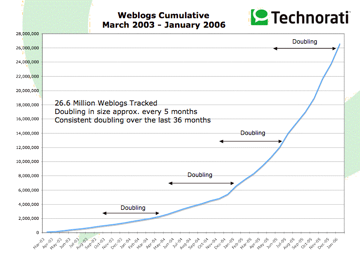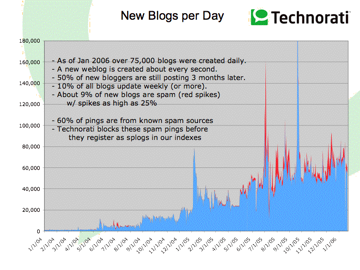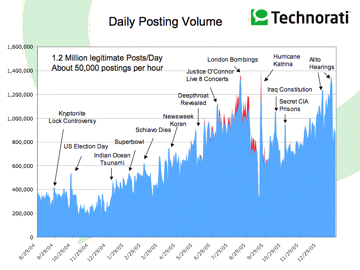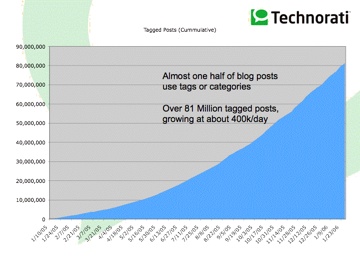In Part 1 of the State of the Blogosphere report, I covered the overall growth of the blogosphere. Today I'm going to cover the growth of the blogosphere as media, and discuss some of the emerging trends that deal with handling information overload. In a world of over 50,000 postings per hour, and over 70,000 new weblogs created each day, keeping on top of and in tune with the most interesting and influential people and topics is the new frontier beyond search. I've also got some surprises for you at the end of this post, two new features that I hope you'll find useful. But first, let's get our hands dirty in the data!
MSM vs. Blogs
To start, let's look at how attention has been shifting in the blogosphere. In the chart below, the top news and media sites are charted according to the number of bloggers linking to them, and clearly, people are still paying a lot of attention to mainstream media stalwarts like The New York Times, CNN, and The Washington Post.

For these sites, which sit on what I call The "Big Head" of the curve (as opposed to the now-famous "long tail", four blogs - BoingBoing, Engadget, PostSecret, and Daily Kos show up. This may look a bit smaller than the data of last August, but a quick look a bit further down the tail starts telling a more interesting story (Note that I've flipped the axes so that you can see more data):
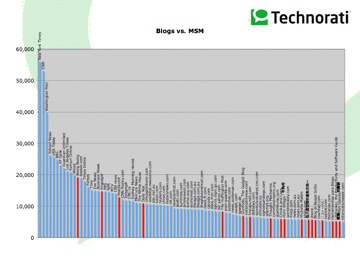
As you continue down the media attention curve past the "big head", that the number of blogs starts to grow.
The Long Tail
The chart below shows the attention curve once you get past the blogs that look just like mainstream media above. It is important to note how long the long tail really is: this chart at this scale doesn't show it - the long tail of the blogging world goes out to 27.2 million blogs. To give a sense of scale, if this chart was kept to the same scale and I printed out the additional sheets necessary on regular 8.5 x 11 inch sheets of paper in landscape mode to show the entire long tail, the length of the complete graph would be about 120 pages long, making the entire chart about 110 feet long!
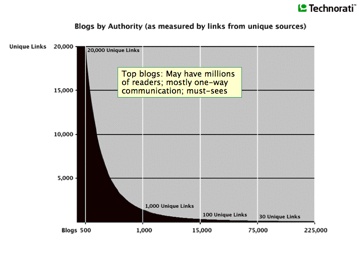
Movement along the curve
With so may blogs and bloggers out there, one might think that it is a lost cause for new bloggers to achieve any significant audience, that the power curve means that there's no more room left at the top of the "A-List".
Fortunately, the data shows that this isn't the case.
Thanks to the Wayback machine, here's a look at the Technorati Top 100 as it appeared on November 26, 2002 (bear with me if the wayback machine is slow). Then look at it as it appeared on December 5, 2003. And again on November 30, 2004. And again on April 1, 2005. And now look at it today.
Let's take a few examples. Have a look at PostSecret. It is the #3 site on the Technorati Top 100 today, with over 12,000 sites that have linked to it in the last 180 days. It didn't even exist on the chart in April of 2005. Or look at The Huffington Post. It is #5 on the Top 100. It too, didn't exist on the chart in April of 2005. Or look at the #47 blog in April, 2005 Baghdad Burning. This blog still is regularly posting, but has fallen to #304.
This should not be meant to imply that there are no network effects, or that a power law relationship doesn't exist in the Blogosphere. Of course there are network effects. But I want to go a level or two deeper than just thinking about the blogosphere as an A-List and The Long Tail -- for that's far too simplistic, and leaves out some of the most interesting blogs and bloggers out there.
The Magic Middle
This realm of publishing, which I call "The Magic Middle" of the attention curve, highlights some of the most interesting and influential bloggers and publishers that are often writing about topics that are topical or niche, like Chocolate and Zucchini on food, Wi-fi Net News on Wireless networking, TechCrunch on Internet Companies, Blogging Baby on parenting, Yarn Harlot on knitting, or Stereogum on music - these are blogs that are interesting, topical, and influential, and in some cases are radically changing the economics of trade publishing.
At Technorati, we define this to be the bloggers who have from 20-1000 other people linking to them. As the chart above shows, there are about 155,000 people who fit in this group. And what is so interesting to me is how interesting, exciting, informative, and witty these blogs often are. I've noticed that often these blogs are more topical or focused on a niche area, like gardening, knitting, nanotech, mp3s or journalism and a great way to find them has been through Blog Finder.
Explore: Dealing with Information Overload
Given that there's a lot of interesting topical posts by influential or authoritative bloggers in those topic areas, we formulated an idea: Why not use these authoritative bloggers as a new kind of editorial board? Watch what they do, what they post about, and what they link to as input to a new kind of display - a piece of media that showed you the most interesting posts and conversations that related to a topic area, like food, or technology, or politics, or PR. The idea is to use the bloggers that know the most about an area or topic to help spot the interesting trends that may never hit the "A-list". We call this new section Explore, and we've seeded it with some of the most interesting topics that we could find. But one of the nice things about Explore is that there are no gatekeepers, and that anyone who writes interesting topical blog posts can get included simply by tagging his blog and tagging his posts.
It's still pretty new, and occasionally an irrelevant post or two sneaks into the display. We're working on fixing that, but one of the new features we're launching today is the ability to subscribe to an RSS feed of any explore category, so you can now read the most interesting posts via your favorite newsreader.
These middle tier blogs also define communities of interest in the blogosphere. Its easy to think of the blogosphere as a cacophony of voices spread out over a big long tail distribution. But Blog Finder and Explore help resolve these thousands of blogs into topical, relevant communities of interest that interlink, refer to one another and often wrestle with ideas, discuss them and move them along. People often ask, "what blogs should I read?" And often times a good answer is, "you should read the posts from the leading blogs in topics that of interest you. Blog Finder and Explore make this possible for the first time on a wide variety of topics--- and in so doing we hope will the blgosphere more approachable, useful, and comprehensible to more people than ever before.
Filter By Authority: Giving YOU the power to tune your searches
There's one more big feature that I wanted to write about tonight, our new Filter By Authority feature. You can see this on all keyword search results pages, looking like this:
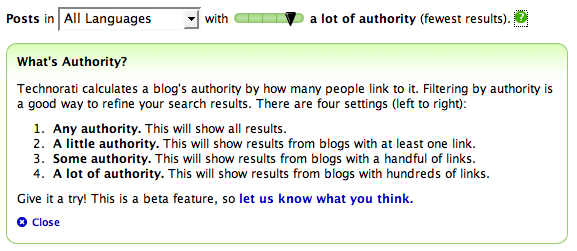
Clicking on the green slider allows you to easily refine your search results to show greater or fewer matching blog posts. For some searches, you might want to pick and choose only posts from blogs that have been around a while and are highly influential - so pick "a lot of authority" as shown above. I've found this great for searches on highly trafficked topics, like "George Bush" or Olympics, or on topics that are known to get a lot of spam, like mortgage or refinance. I find that it often helps me to also answer the question, "Who is the most influential blogger talking about XXX this week, and what did she say?"
Clicking lower on the slider gives you the ability to see how different levels of filtering affect your search results. For my ego feeds, I always want to see every single mention, so I turn off filtering for those feeds. I also love looking at the charts on the left-hand side of each search result to see what changes when I change the filter, too.
As we implemented this feature, we spent a lot of time thinking about how to name it. We frequently use the term authority on our site when we talk about inbound links, as in "a link is a vote of authority." So to maintain consistency we called this new feature, " sort by authority." But in no way should this imply a value judgment. More authority doesn't necessarily mean more good or more interesting. In many instances, less authority yields more interesting results: a greater diversity of opinion, less mainstream thinking, more individual voices. The authority filter is a tool to fine tune results, and its a great way to zoom in on the voices that are commanding the most attention, and then zoom back out and listen to the whole diverse medium that is the blogosphere. With so many voices we're happy to add a new tuning control!
This new feature is a beta feature, so we're looking for your feedback! Do you like it? Find it useful? Or is it confusing? What about the name? We tried a number of different names for the feature, but ended up picking "filter by authority" since we speak about a blogger's authority as being based on the number of links he gets from other people, but it isn't a perfect analogy. In the end, we decided that rather than having the perfect name, we'd much rather get the feature out there for all of you to try, and we'd listen intently to your feedback and comments.
In Summary
- Blogging and Mainstream Media continue to share attention in blogger's and reader's minds, but bloggers are climbing higher on the "big head" of the attention curve, with some bloggers getting more attention than sites including Forbes, PBS, MTV, and the CBC.
- Continuing down the attention curve, blogs take a more and more significant position as the economics of the mainstream publishing models make it cost prohibitive to build many nice sites and media
- Bloggers are changing the economics of the trade magazine space, with strong entries covering WiFi, Gadgets, Internet, Photography, Music, and other nice topic areas, making it easier to thrive, even on less aggregate traffic.
- There is a network effect in the Technorati Top 100 blogs, with a tendency to remain highly linked if the blogger continues to post regularly and with quality content.
- Looking at the historical data shows that the inertia in the Top 100 is very low - in other words, the number of new blogs jumping to the top of the Top 100 as well as he blogs that have fallen out of the top 100 show that the network effect is relatively weak.
- The Magic Middle is the 155,000 or so weblogs that have garnered between 20 and 1,000 inbound links. It is a realm of topical authority and significant posting and conversation within the blogosphere.
- Technorati Explore is a new feature that uses the authoritative topical bloggers as a distributed editorial team, highlighting the most interesting blog posts and links in over 2,500 categories.
- The new Filter By Authority slider makes it easy to refine a search and look for either a wider array of thoughts and opinions, or to narrow the search to only bloggers that have lots of other people linking to them. This gives you the power to decide how much filtering you want.
Technorati Tags: authority, beta, blogs, blogsearch, charts, explore, filter, msm, search, search engine, sotb, sotb2006, statistics, stats, weblog, weblogs

 ) to add that blog to your favorites. Looking for good blogs on a certain topic? Check out
) to add that blog to your favorites. Looking for good blogs on a certain topic? Check out 






